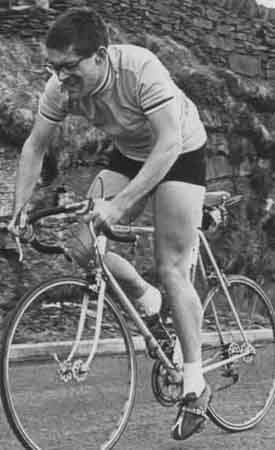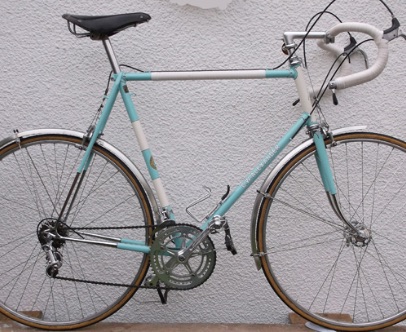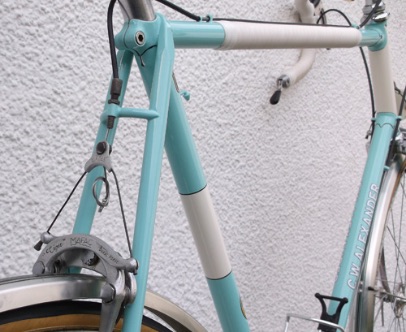Alexander, C W 'Charlie'
Posted: Tuesday 12th May 2020
The great Cardiff bike shop between the 1940’s and the 1980’s was Charlie Alexander’s at 25 James Street in the Docks. Charlie catered for everyone from dock workers’ punctures to building frames and wheels for world champions and Tour of Britain riders.
Charlie was a tiny balding figure with a woollen peaked cap down over his brow. His piercing eye and manner made him a formidable character. Going into the shop, he would often be found hunched over a wheel jig. He would glance up and if you were in favour, give a nod and return to his work. “Charlie”, the terrified customer would stammer, “Have you got a 52 tooth Campag chainring?” “Yes”, would come the stern reply and a return again to the jig. Silence then for some time. “Charlie, could you sell me a 52 tooth Campag chainring?” “Yes, why didn’t you say so in the first place!”

It was built in Charlie Alexander’s shop by Cliff Smith – the two of them built the frames – if you were not “in favour” in the shop you might wait a couple of years for your frame – but mine was built in about two weeks ready for the 1966 Milk Race. It replaced an Eddie Soens frame which several of us in Cardiff Ajax were riding at the time.
The frame was straightforward like all the ones they built – 531 – Nervex Professional lugs or plain Prugnat? – mine was built for my size and weight with the then fasionable “five eigths” seat stays – size 25” – Campag ends – 73/73? – finished in powder blue with red/white/blue tricolour head and seat bands – much later resprayed orange with the same bands I think. It was still in use up to 1987.
Bike built up with Campag gears (double handlebar controls) – TA Criterium chainset – I’d had a couple of Williams cotterless chainsets given me but they had cracked – Cinelli steel stem and alloy bars – Brooks Professional saddle – Campag seatpin – Universal centre-pulls – Fiamme rims- Pirelli Leggero tubs – Gran Sport large flange hubs –
six-speed block – various Campag cable clips and pump peg – Brampton pedals – Christophe toe-clips – Detto Pietro shoes – Anquetil shoe-plates and one of those strip metal bottle cages with a spring clip which were suddenly back in fashion at that time.
The picture was taken in March 1967 during the four mile uphill time trial stage of the South Wales Three Day in Mountain Ash. There was a reasonable field including Keith Stacey, Roy Hopkins, etc., with Stacey winning overall. It was Easter and the weather was grim with snow, rain and wind.
If you were not a favoured customer you might leave a wheel for truing then return six months later to ask about its fate. Charlie would take it down off the hook, blow the dust off it, and say “Ready next week.
The nerve centre of the shop was in the basement/cellar workshop. Here Cliff Smith reigned supreme. Cliff was a master of the welding torch (only steel frames in those days) and would build you a perfect frame in a week. Cliff died at a tragically early age and his working conditions can hardly have helped. The cellar was gloomy, low-ceilinged with an oil-soaked floor while the atmosphere reeked of oxy-acetylene, paint from the spray booth and the exotic perfume of Senior Service and Capstan Full Strength cigarettes. The endless pint mugs of sweet, mahogany-coloured tea probably didn’t help either. The workshop was always full of bike-riders breathing the same mixture (which would have given a positive dope test these days) and swapping yarns – much the same as today, I guess.
Cliff was always cheery, outgoing, with a string of jokes and all the latest gossip from South Wales cycling. His skills meant that he could build you a frame that would last you a lifetime, that would be responsive in racing and yet as comfortable as an armchair. The crowning touch to an Alexander frame was a stainless steel “A” cut out and brazed to the head tube.
The shop was a four-storey Victorian building in James Street, now demolished. Getting in through the front door was always difficult. The door would open a little way, its bell on a spring clanging furiously, then jam against the floor. Charlie was open all hours and could often be found at any time up to midnight working away to the strains of grand opera on tape. He was interested in and knowledgeable about everything. During the Second World War he had served in Egypt and India which led to X-rated stories which could not be repeated in polite company.
The shop wound its way up flight after flight of stairs to the fourth floor. The higher you went the more worm-eaten the steps became and the larger were the holes in the floorboards. Inching your way cautiously around the holes to avoid crashing through to the floor below, you might be rewarded by the sight of the latest cycling accessories of 1938 which Charlie had brought back from the Cycle Show in London and which never quite got round to selling.
My generation knew Charlie in his later years but even then he was actively racing and supporting others. When young he had been a strong road and track rider and record holder and then raced into his 70s, riding 24-hour time trials toward the end of his career.
Charlie died in around 1990 at the age of seventy-eight riding back from the local VTTA Christmas dinner – just fell off dead in the road after not having had a day’s illness in his life.
I’m sure modern shops have their moments but we will never see the like of Charlie’s again. From the medieval atmosphere of the cellar to the dizzying heights of the ancient accessories on the fourth floor, to Charlie’s varying moods, a trip there was always an adventure and you never quite knew what you would find.
“As a competitive 15 year old in 1966 I bought one of Charlie Alexander’s road bikes second hand. It was a beautiful bike, with an all Campagnolo spec with mavic sprints etc. To this day I regret selling it… but I did. It was said at the time that it was built for a Welsh champion. I don’t know about that, but reading the article it could well have been true.
I have never seen another Alexander since. Indeed I was at a meeting at the Kettering track in about 1967 when somebody stopped me to look at the Alexander. He was bowled over to see it, with its distinctive A on the headset. It was he who said they were made in Cardiff, and he said at the time only 52 of them had been built.
I have often wondered if I could find another, but no – never a mention in the last 43 years. So imagine how pleased I was to read that article.”
tells us of an Alexander that he had built in 1965 or 66 in Cardiff. He was a regular visitor to the shop in Cardiff and his memories are similar to Roger Pratt’s:
I raced the bike back then and used it regularly ever since, having since had some careful restoration done at Argos about five years ago. Below is a detailed description of the bike and some photos.


| Frame | 25"” C.W.Alexander; frame number AL 25/30 (1965/66); 74° x 71°; 39¾” wheelbase; Reynolds db throughout; Campag end and original chrome. Campag Record headset and seatpin 27.2. The frame was repainted by Argos in Turkish Green with white contrasts and original transfers faithfully reproduced. Bluemells tape on top tube for protection. |
| Wheels | Fiamme sprint rims on Campag Record large flange hubs 36/40 spoking; Wolber tubs and 14-24 freewheel. |
| Chainset | Campag Strada; 54-46 chainrings; Strada bottom bracket |
| Pedals | Campag Record with Christophe toeclips and straps |
| Gears | Campag Nuovo Record rear and “old type” Record front changer with Campag bar end shifters. |
| Brakes | Mafac “Tiger” centre pull with Mafac levers and NOS half hoods |
| Stem/Bars | Cinelli 1A x 14cm, oval badge with Cinelli Campione del Mondo bars 66 x 42. Bluemells NOS bar tape |
| Saddle | Brooks B17 Champion standard with narrow rails |
| Mudguards | Early SKS Bluemells narrow silver. |
Posted: Tuesday 12th May 2020
This article appears in the following categories.
Upcoming Events
Whether you are looking for a gentle social meet up, or a 100-mile ride browse the community’s upcoming events and plan your next weekend outing.
